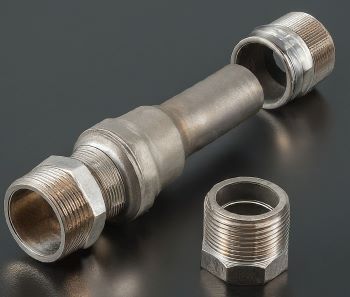In the world of plumbing, hydraulics, and various fluid transfer systems, reliable connections are paramount. Leaks can not only be frustrating and costly, but in critical applications, they can pose safety hazards. Flared pipe fittings offer a dependable solution, but their success hinges on proper installation.
Understanding Flared Pipe Fittings
Flared Pipe Fitting Components
A flared pipe fitting consists of three main parts:
➡️ Body: The main housing of the fitting, with a threaded end for connection and a tapered bore to receive the flared pipe.
➡️ Nut: This slides over the body and the flared pipe, compressing the flare to create a tight seal.
➡️ Sleeve: (Optional on some designs) The sleeve rests against the pipe end and provides additional support for the flare during tightening.
There are two main types of flares used with flared pipe fittings:
➡️ SAE Single Flare: This is the most common type, featuring a single, cone-shaped flare at the end of the pipe.
➡️ SAE Double Flare: As the name suggests, this type has a double cone shape, offering a more secure seal but requiring a specialized flaring tool.
Flared pipe fittings boast several advantages:
➡️ Durability and Leak Resistance: The metal-to-metal contact created by the flare ensures a strong, leak-resistant connection.
➡️ Easy Assembly and Disassembly (when done correctly): Flared fittings can be reused after disassembly, making them ideal for applications requiring periodic maintenance.
➡️ Wide Range of Sizes and Materials: Flared fittings come in various sizes to accommodate different pipe diameters and are available in materials like brass, copper, and stainless steel to suit various applications.
Tips for Successful Installation of Flared Pipe Fittings
Flared pipe fittings offer many benefits. But, you need to install them correctly to get a secure, leak-free connection. Here are a few important actions to take:
✅ Choosing the Right Fitting: Select a fitting with the appropriate size and thread type to match your pipe. Ensure the fitting material is compatible with the fluid being used.
✅ Preparing the Pipe: Cut the pipe to the desired length using a pipe cutter. Deburr the cut end to remove any sharp edges that could damage the flare or fitting.
✅ Flaring the Pipe: This is a critical step. Use a high-quality flaring tool specifically designed for the type of flare you’re creating (single or double). Follow the tool’s instructions carefully to achieve the correct flare dimensions. Avoid over-flaring, as this can weaken the pipe.
✅ Assembling the Connection: Slide the nut and sleeve (if applicable) onto the pipe. Insert the flared pipe end into the body of the fitting. Tighten the nut by hand as much as possible, then use a wrench to tighten further according to the fitting manufacturer’s recommendations. Don’t overtighten, as this can damage the fitting or pipe.
✅ Leak Testing: Once assembled, perform a leak test. Apply pressure to the system using air or water and visually inspect for leaks. Tighten any loose connections if necessary. Never use gas for leak testing.
Common Mistakes to Avoid
Even with careful planning, mistakes can happen during installation. Avoid the following frequent pitfalls:
1. Using the wrong size or type of fitting: Double-check the size and thread compatibility before assembly.
2. Improperly preparing or flaring the pipe: Ensure a clean, deburred cut and use the correct flaring tool and technique.
3. Overtightening or under-tightening the connection: Follow the recommended torque specifications for secure connections without damaging components.
4. Using damaged or low-quality components: Inspect fittings and pipes for damage before use. Opt for reputable brands to ensure quality and reliability.
Check out these other resources:
✅ The Key To Efficiency: SAE 4 Port Essentials
✅ Mastering Hydraulic Bullhead Tees: Tips And Tricks
Applications of Flared Pipe Fittings
Flared pipe fittings are versatile and reliable. They are suitable for many applications.
✅ Plumbing (both residential and commercial): Commonly used for water supply lines, gas lines (where local codes permit), and compressed air systems.
✅ Hydraulic and pneumatic systems (e.g., construction equipment, machine tools): Transferring hydraulic fluid and compressed air for powering machinery and tools.
✅ Refrigeration and air conditioning systems: Connecting refrigerant lines in AC units and refrigeration systems.
✅ Oil and gas applications (low-pressure): Suitable for low-pressure oil and gas lines (always check local codes and regulations).
Conclusion
Flared pipe fittings are a reliable and versatile solution. They are for connecting pipes in fluid transfer. Follow the proper installation techniques above. They will ensure secure, leak-free connections. This is key for the best system performance.
It’s important to note that flared fittings offer many advantages. But, there are other fitting options. These include soldered or crimped connections.
Post time: May-10-2024


